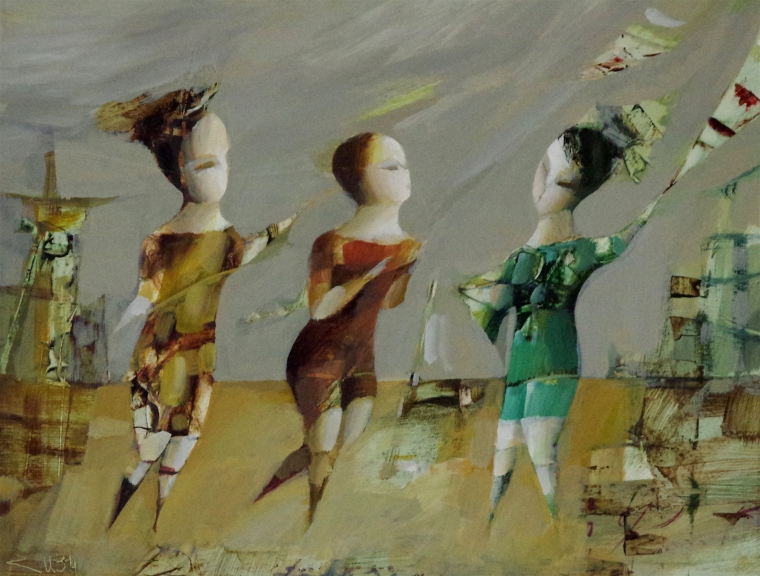Figurative Oil Painting: From Idea to Canvas - A Step-by-Step Method
Figurative Oil Painting: From Idea to Canvas - A Step-by-Step Method
Blog Article
The Duty of Feeling and Expression in Figurative Oil Painting: A Thorough Evaluation of Topic and Make-up
The interaction of feeling and expression in figurative oil paint offers as a critical lens through which one can analyze the detailed partnership in between subject issue and structure. Artists harness numerous techniques, from color choice to brushstroke characteristics, to cultivate emotional resonance within their works.
Understanding Feeling in Art
Emotion in art offers as an effective avenue for expression, enabling musicians to convey intricate feelings via their job. In metaphorical oil painting, this emotional depth is commonly represented with the representation of the human number, capturing the nuances of human experience. The option of subject, shade palette, and brushwork all contribute to the psychological resonance of a piece.
Artists often bring into play individual experiences, societal problems, or global styles to stimulate feelings in the audience. A picture might show susceptability, while a dynamic figure in motion can symbolize flexibility or turmoil. These emotional threads link the customer to the art work, fostering a discussion that goes beyond the visual medium.
Furthermore, the interplay between light and darkness can intensify psychological strength, guiding the visitor's look and accentuating particular elements within the structure. Using texture in oil paint even more adds layers of intricacy, welcoming a tactile action that improves the emotional experience. On the whole, recognizing feeling in art is essential for appreciating the subtleties that identify figurative oil painting, as it transforms plain depiction into an extensive expedition of the human condition.
Crucial Element of Structure
In the realm of figurative oil painting, the make-up functions as the underlying framework that arranges visual elements and boosts the emotional narrative. Important components of make-up include balance, comparison, prime focus, and rhythm, each contributing to the total influence of the art work.
Balance describes the circulation of visual weight within the painting, which can be attained via asymmetrical or symmetrical arrangements. A healthy make-up offers stability, allowing the visitor to engage with the item sympathetically - figurative oil painting. Comparison, on the other hand, involves comparing various aspects, such as light and dark or cozy and amazing colors, to direct the audience's eye and stimulate emotional feedbacks
The centerpiece is critical, as it guides focus to the most substantial part of the painting, commonly highlighting the emotional core of the narrative. Via methods like color saturation or placement, musicians can emphasize this area efficiently. Last but not least, rhythm refer to the rep of elements, producing a feeling of activity and flow throughout the structure. By skillfully incorporating these crucial elements, musicians can craft engaging and psychologically powerful metaphorical oil paints that mesmerize and engage their audience.
Subject Matter and Its Effect
Subject issue plays a critical function in metaphorical oil painting, as it not only works as the structure for the story yet additionally forms the visitor's interpretation and emotional interaction with the artwork. The choice of subject-- be it a singular number, a team dynamic, or a thematic representation-- directly affects the psychological ambience communicated to the target market.

For example, portraits typically stimulate individual links, revealing the ins and outs of human expression and character, while scenes showing public activities can develop a sense of belonging or fond memories. Moreover, the historical and social context of the subject improves the customer's understanding, prompting much deeper representations on societal norms, values, and the human problem.
Various subjects additionally generate varying degrees of engagement; a remarkable problem portrayed via numbers in tension may evoke sensations of anxiety or compassion, while calm landscapes can invoke serenity and reflection. Ultimately, the effect of topic in metaphorical oil painting is profound, as it serves as a channel for psychological vibration, guiding the audience's action and analysis, and cultivating a connection in between the observer and the artwork. This interplay is necessary for the effective interaction of the musician's intent.
Strategies for Stimulating Feelings
The effectiveness of figurative oil painting in conveying feelings is considerably affected by the strategies used by the musician. Among one of the most essential approaches is making use of shade concept, where the critical option of tones can stimulate details psychological actions. Cozy shades, such as oranges and reds, usually elicit feelings of passion or aggressiveness, while cooler tones like blues and environment-friendlies often tend to site stimulate peace or unhappiness.
An additional important technique is the control of light and darkness, called chiaroscuro. This method enhances the three-dimensionality of figures, producing dramatic contrasts that can increase psychological deepness. The positioning of light can direct audiences' emotions, highlighting specific components of the structure.
Brushwork also plays an important role; loose, meaningful strokes can communicate energy and spontaneity, whereas smoother techniques could suggest why not try these out tranquility or accuracy. Moreover, the arrangement of topics within the composition can affect emotional influence. Close closeness can suggest affection, while distance might suggest seclusion.
Eventually, the combination of these methods enables musicians to craft narratives that reverberate with the audience, changing a mere aesthetic experience into an expressive emotional journey. - figurative oil painting

Study of Notable Works
Checking out noteworthy works of metaphorical oil painting reveals exactly how various methods are used to stimulate powerful emotions. One excellent situation is Edvard Munch's "The Scream," where the distorted figure and swirling background share existential dread. Munch's use of color-- deep blues and brilliant oranges-- magnifies the emotional effect, showcasing just how combination choices can shape audience experience.
An additional considerable work is Pablo Picasso's "Les Demoiselles d'Avignon." Below, fragmented kinds and bold brushstrokes mirror a troubled psychological landscape, challenging standard representations of the women number. Picasso's cutting-edge make-up not just catches the audience's attention but also welcomes reflection on motifs of identification and sexuality.
Furthermore, Frida Kahlo's "Both Fridas" offers a poignant expedition of duality and self-identity. The different figures, linked by a common heart, exemplify Kahlo's emotional deepness and individual narrative. figurative oil painting. Her meticulous focus to detail and symbolic elements offer to engage viewers on a natural degree
These situation studies emphasize the profound connection in between emotion and make-up in metaphorical oil painting, disclosing exactly how artists harness strategy to interact complex sensations and narratives that resonate across time and society.

Verdict
To conclude, the interaction of feeling and expression in figurative oil paint considerably boosts the audience's experience and analysis of the artwork. With a mindful selection of topic and compositional techniques, artists share profound narratives that reverberate on both individual and universal levels. The application of color chiaroscuro, brushwork, and concept more magnifies psychological depth, transforming each canvas into an effective representation of the complexities of the human experience.
In figurative oil painting, this psychological deepness is frequently depicted via the depiction of the human figure, catching the subtleties of human experience.In addition, the interplay between light and shadow can intensify psychological intensity, directing the audience's look and attracting focus to certain elements within the composition. The use of structure in oil painting additionally includes layers of intricacy, welcoming a responsive response that enhances the emotional experience.The focal factor is crucial, as it directs attention to the most significant part of the painting, frequently highlighting the emotional core of the narrative. Ultimately, the impact of subject matter in figurative oil painting is extensive, as it serves as a channel for psychological vibration, guiding the Learn More viewer's action and analysis, and cultivating a link between the art work and the onlooker.
Report this page